Every teacher dreams of a classroom where students are engaged, disruptions are minimal, and learning thrives. Yet, achieving this utopia often seems elusive.
According to the National Center for Education Statistics, over 40% of teachers consider classroom management their biggest challenge. So, how can you conquer this hurdle?
- Discover core principles of effective classroom management
- Learn tailored strategies for different age groups
- Discover classroom management strategies across all education levels and classroom scenarios
- Integrate modern tools, like ClassPoint, to enhance student engagement
Ready to transform your teaching experience? Dive in as we unveil proven classroom management strategies and free resources that lead to harmonious and productive learning environments.
The Foundation of Effective Classroom Management Strategies
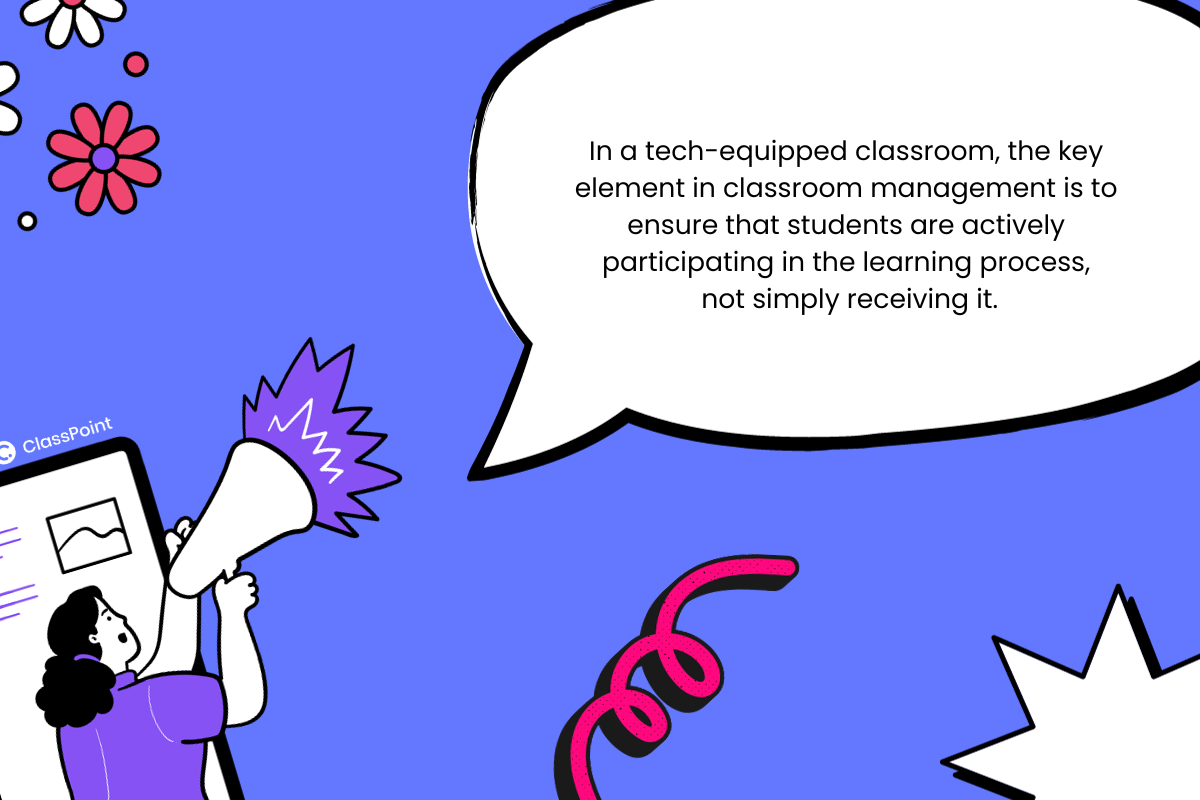
What Are Classroom Management Strategies?
Classroom management is more than just keeping a classroom quiet—it’s about creating a positive, structured environment where students are engaged, motivated, and feel safe. At its core, classroom management strategies are the techniques teachers employ to foster optimal student behavior and learning outcomes.
Effective Classroom Management Strategies for New Teachers
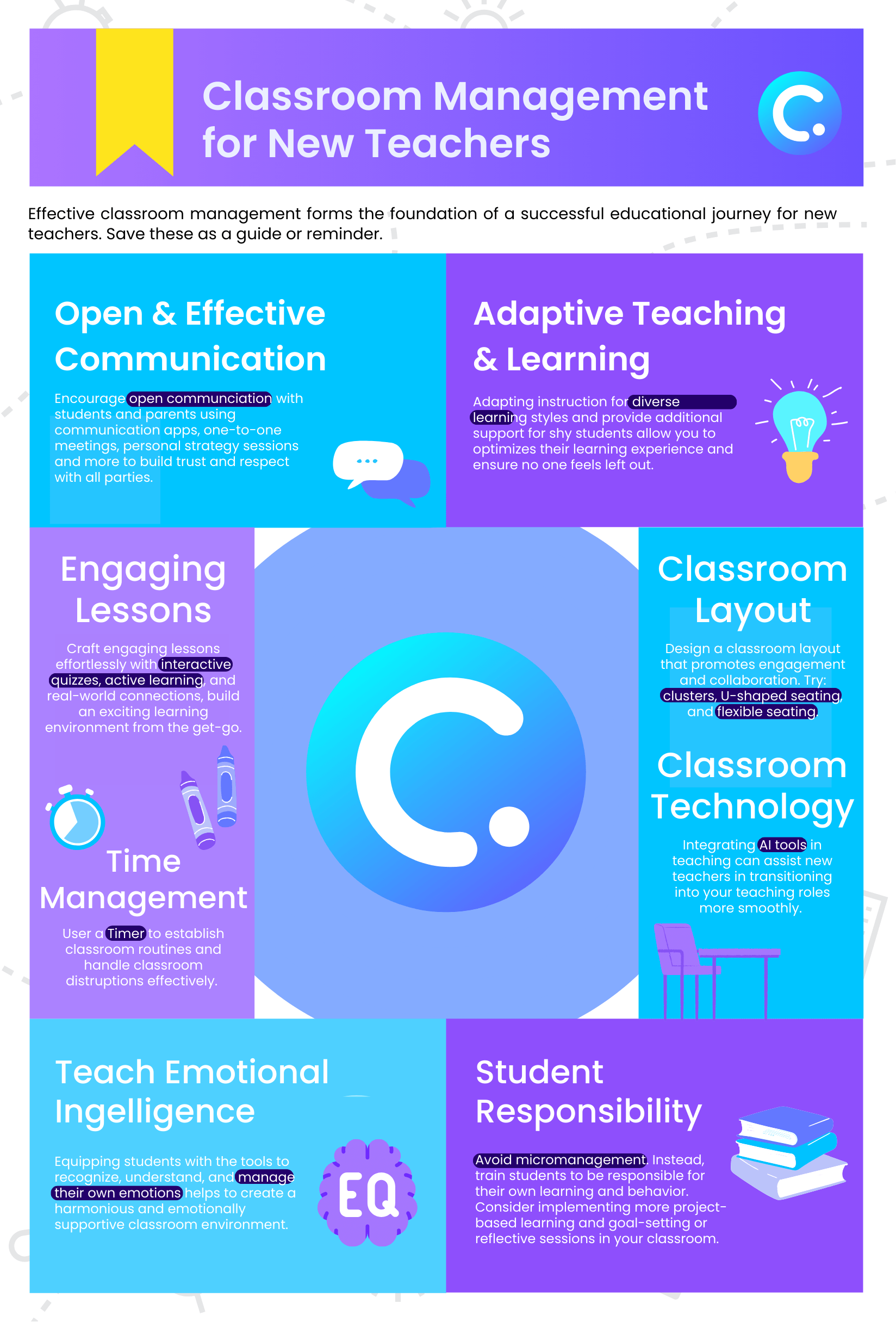
New educators, take note! Navigating classroom dynamics can be challenging, but with the right tools, you can set a positive tone from day one:
- Consistency is Key: Ensure rules are maintained daily.
- Positive Reinforcement: Celebrate good behavior to motivate students.
- Clear Communication: Keep instructions straightforward, ensuring all students understand.
Are you a budding educator seeking more tailored tips? Dive into our detailed blog post designed especially for new teachers and their unique challenges.
Classroom Strategies for Behavior Management
Navigating the maze of behavior in a classroom is no small feat. The key? Deploying strategies that preemptively curb disruptions and maximize learning.
- Set Clear Expectations: Right from the get-go, establish boundaries. This doesn’t just make your life easier; it provides students with a clear framework.
- Frequent Check-ins: Instead of just lecturing, weave in moments where you connect with students, ensuring they’re on track and understanding the material.
- Immediate Addressal: Procrastination isn’t your friend. Nip disruptions in the bud.
Yearning to master the art of behavior management? Here's a helpful blog that walks you through resolving conflicts in the classroom.
Fun Classroom Management Strategies
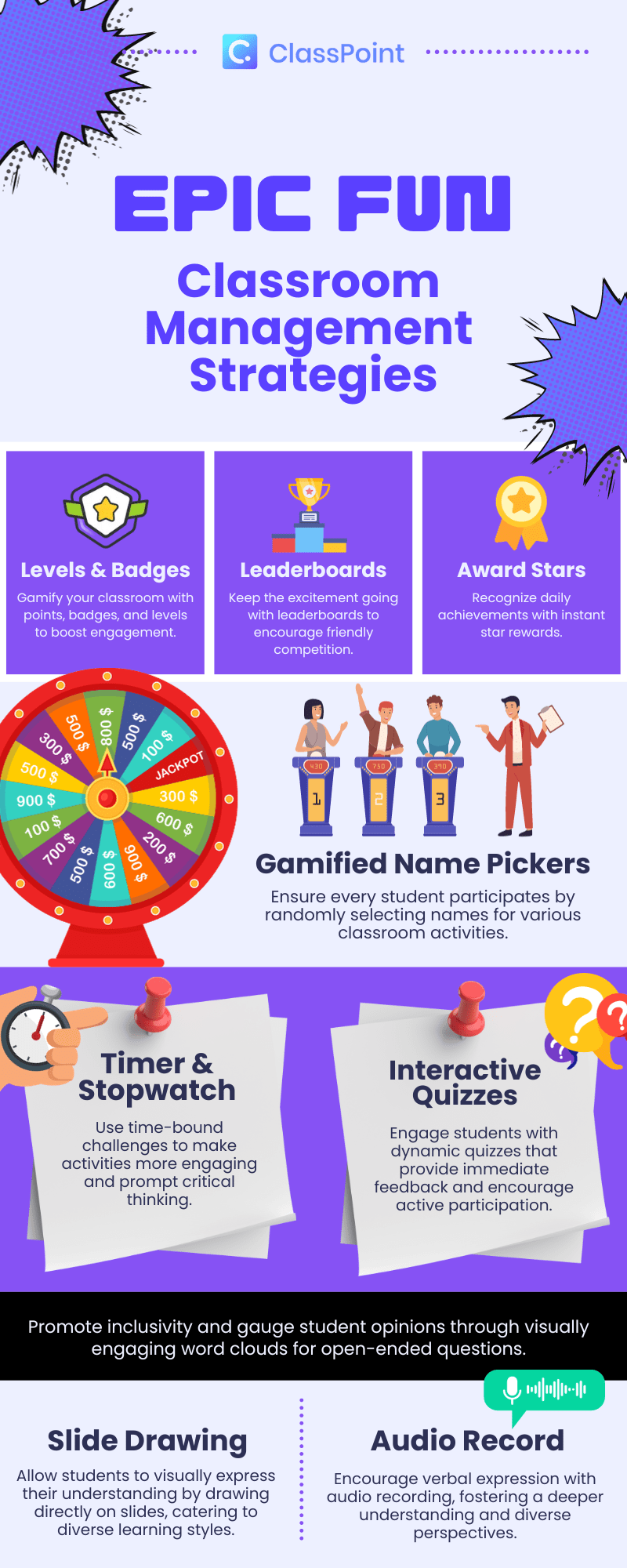
Whoever said classroom management strategies have to be monotonous clearly hadn’t encountered the world of fun strategies. Let’s dive into some that make both teaching and learning not just effective, but truly enjoyable.
- Gamification: Everyone loves games, and when you merge them with learning, you strike gold. For instance, if you want to enforce punctuality, create a scoreboard. Students who arrive on time for a week straight might earn a “Power Punctuality Badge.” This not only instills discipline but does it in a spirited, competitive manner.
- Creative Rewards: Let’s go beyond the conventional stars and stickers. How about a “Principal for a Day” reward for consistent good behavior? Or maybe a lunchtime storytelling session for a student who demonstrates the month’s core value, like kindness or diligence.
- Themed Days: Spice up your week with themed days like “Silent Reading Fridays” or “Debate Wednesdays”. These aren’t just fun; they offer students a break from routine, keeping them engaged and eager.
Hungry for more? Dive into our dedicated resources where fun classroom management strategies take the center stage!
Need a fun icebreaker idea? Check out this cool expert guide 👇
Need more ideas to make your presentations fun for the whole class? 👇👇
Positive Classroom Management Strategies
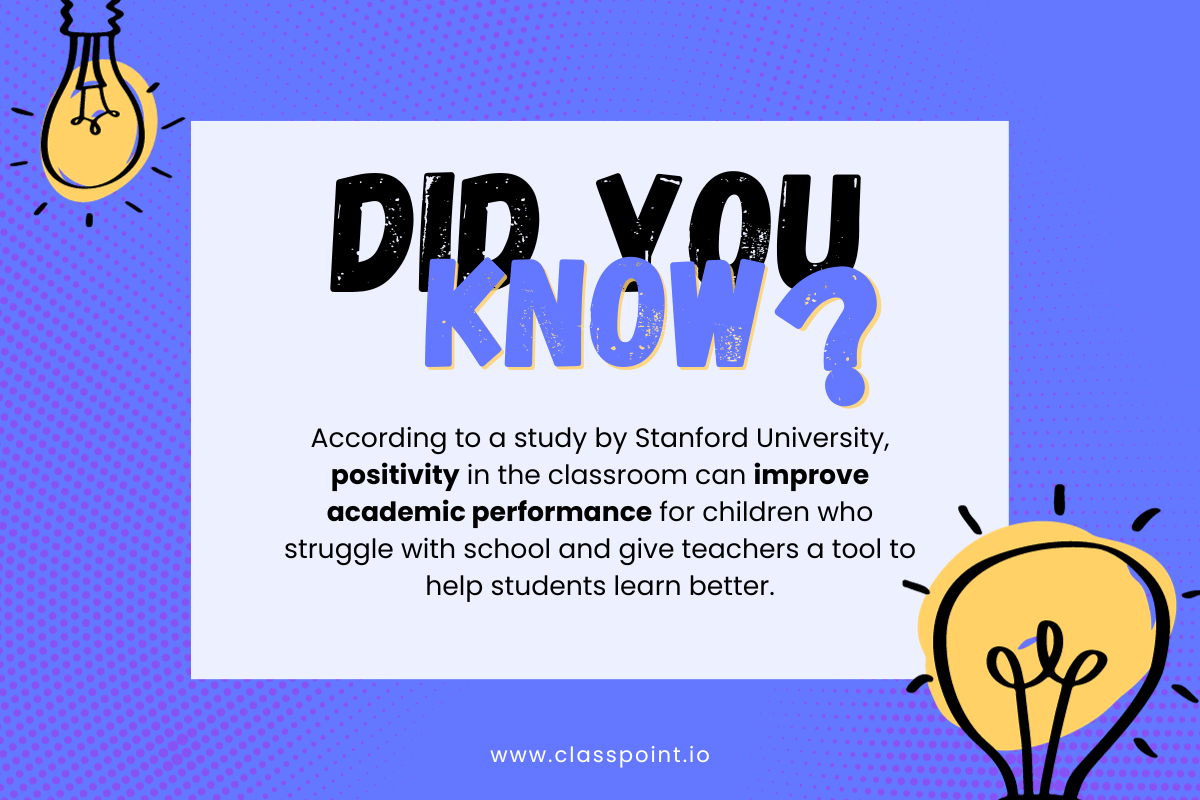
Sprinkle positivity with:
- Celebrating Achievements: Every win, whether small or monumental, deserves acknowledgment.
- Constructive Feedback: It’s not what you say but how you say it. Constructive criticism fosters growth.
Keen on creating a positive aura in your classroom? Delve into our guide that centers on the power of positivity.
Preschool Classroom Management Strategies
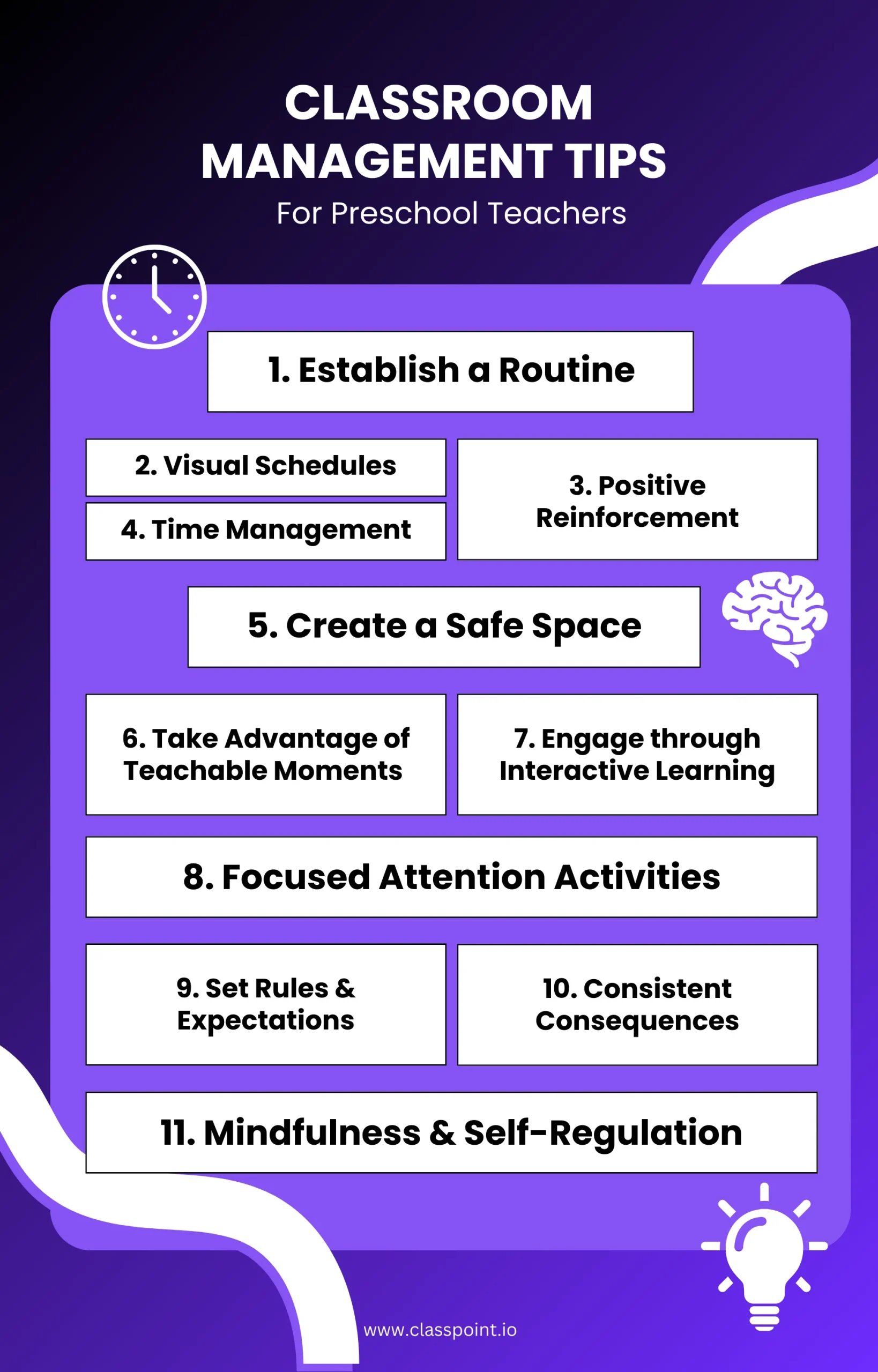
A classroom’s atmosphere is pivotal in shaping how students perceive their learning environment. Adopting positive classroom management strategies can transform a classroom into a space where students feel valued, heard, and enthusiastic about learning.
- Praise Over Punishment: Rewarding students for good behavior or outstanding work can have a more lasting impact than disciplining them for minor misdemeanors. A simple acknowledgment of their efforts can boost their morale immensely.
- Constructive Feedback: Instead of highlighting what a student did wrong, point out what they did right and then suggest areas of improvement. For instance, “Your approach to solving this problem was creative! Have you considered trying this method as well?”
- Open Dialogue: Encourage students to express their feelings and concerns. An open forum every month where students can discuss any classroom issues can foster understanding and unity.
- Celebrate Milestones: Recognize and celebrate both big achievements and small wins. Whether it’s the completion of a challenging project or a student mastering a difficult concept, every accomplishment deserves applause.
- Visual Positivity: A simple strategy involves decorating the classroom with positive affirmations, encouraging quotes, and students’ achievements, creating a visually stimulating and motivating environment.
Dive deeper with our comprehensive guide on 32 preschool classroom management strategies.
Classroom Management Strategies for Elementary School
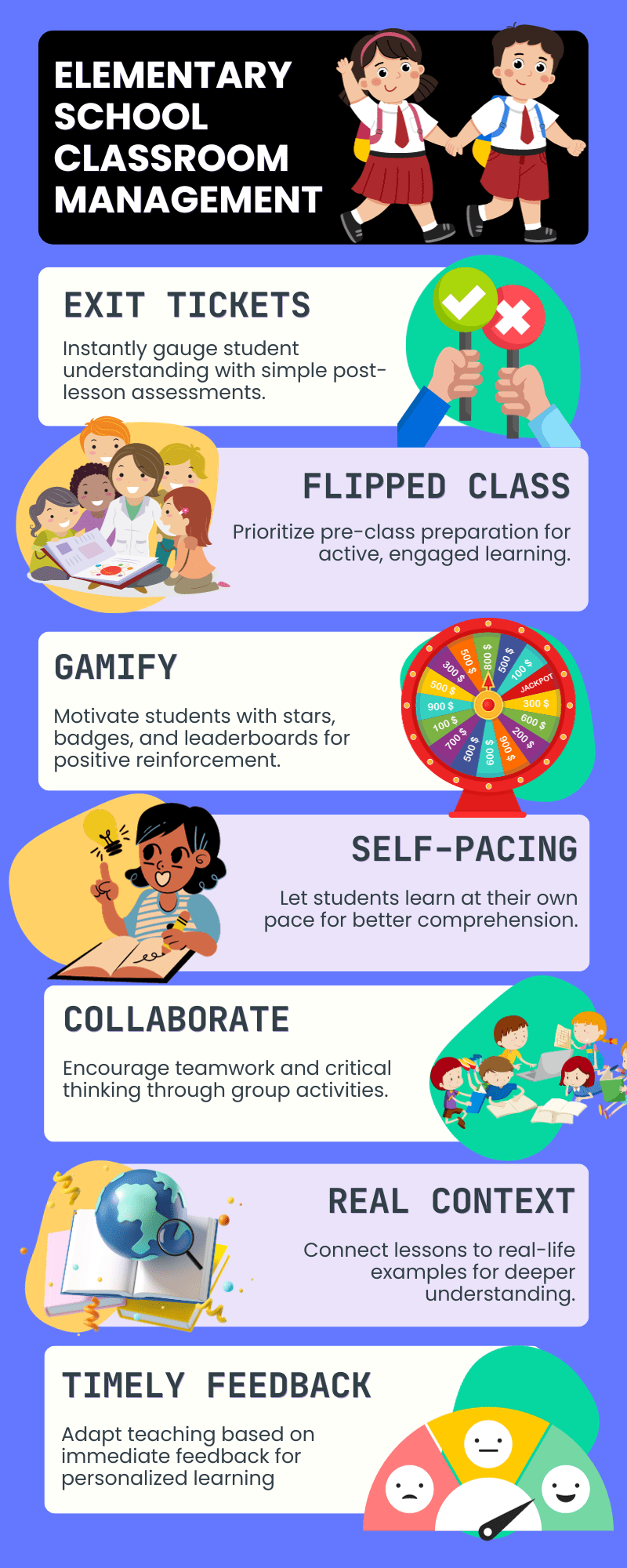
Elementary school is a pivotal phase in a student’s academic journey, laying the foundation for their future learning experiences. Thus, crafting an environment that nurtures growth while maintaining discipline is vital. Here’s a deep dive into the classroom management strategies tailored for younger minds.
- Structured Routines: At this age, students thrive on predictability. Establishing a clear, daily routine helps children understand expectations and flow through their day seamlessly. For instance, having designated times for reading, recess, and group activities creates a familiar rhythm that minimizes disruptions.
- Positive Reinforcement: Celebrate small victories! Whether it’s mastering a math problem or sharing with a classmate, acknowledging positive behaviors can do wonders. A study by Jones & Jones highlighted the power of praise in reinforcing desirable classroom behavior.
- Visual Schedules: Young minds are often visual learners. Displaying a colorful, picture-based schedule of the day’s activities keeps students engaged and informed, reducing the constant “What’s next?” questions.
- Interactive Learning Spaces: Create areas in the classroom dedicated to specific activities—maybe a cozy reading nook or a hands-on science corner. This not only breaks the monotony but also caters to various learning styles.
- Open Communication: Foster a culture where students feel comfortable voicing concerns or asking questions. Regular class meetings where they can share their feelings promote inclusivity.
Keen on more insights tailored for younger students? Delve deeper into 7 proven classroom management strategies for elementary school.
Classroom Management Strategies for Middle School
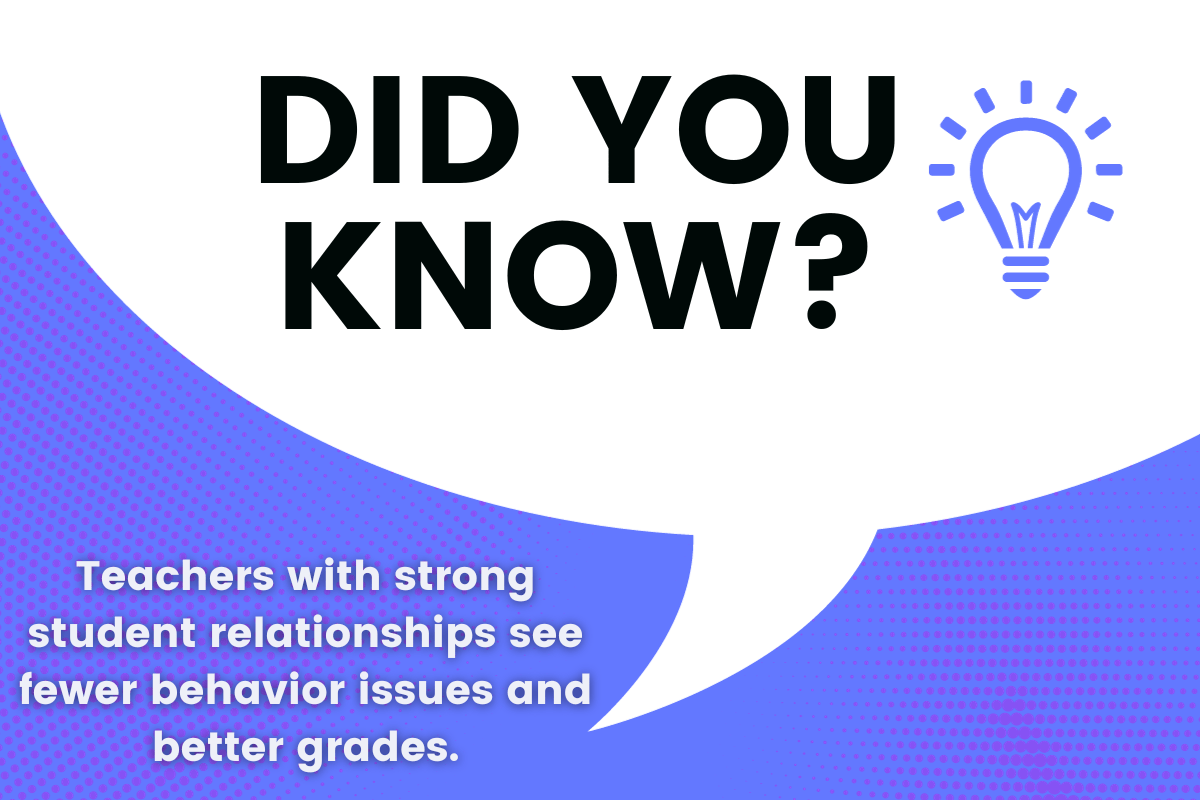
Middle school presents its own unique challenges: students teeter between childhood and adolescence, seeking independence while also craving structure. The complexity of this stage demands nuanced classroom management strategies to navigate these transitional years effectively.
- Building Relationships: As students begin to form their identities, they highly value genuine connections. Foster trust by showing genuine interest in their lives. According to a Harvard report, a positive teacher-student relationship significantly influences academic success and behavior.
- Clear & Consistent Boundaries: Set unambiguous classroom rules from day one. And more importantly, ensure consistent enforcement. This clarity avoids confusion and asserts authority without being authoritarian.
- Engaging Curriculum: Middle schoolers have a shorter attention span but are incredibly curious. Tapping into this curiosity with engaging, relevant content keeps them invested. Interactive tech tools or real-world applications of lessons can be game-changers.
- Peer Mediation: Conflicts among peers escalate during these years. Having a structured peer mediation process helps students resolve differences, teaching them invaluable conflict resolution skills in the process.
- Student Autonomy: Empower students by offering choices. Whether it’s selecting a project topic or choosing between tasks, giving them a sense of agency can boost engagement and responsibility.
Craving deeper insights tailored to the middle school environment? Dive into 27 highly transformative classroom management strategies for middle school teachers.
Classroom Management Strategies for High School
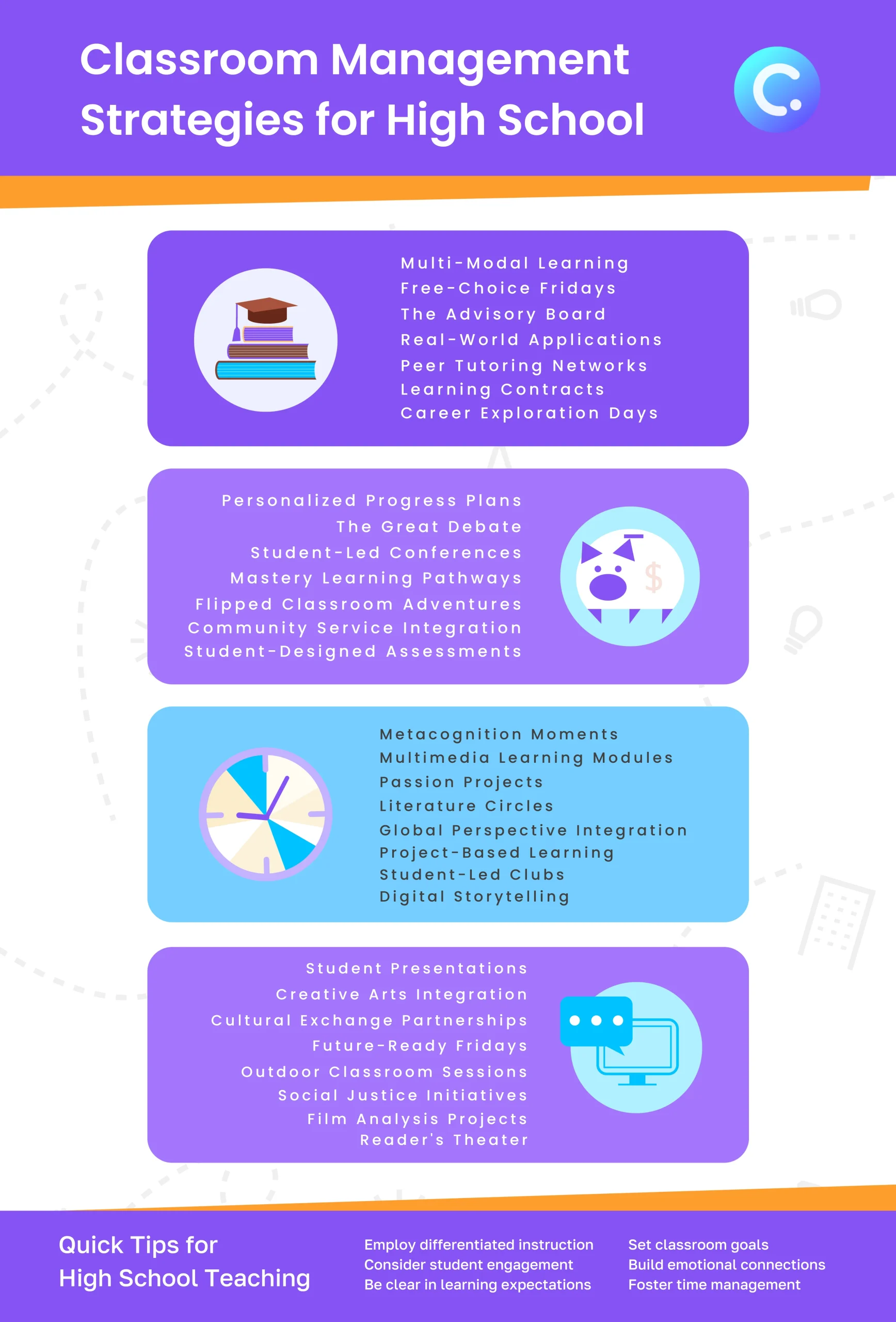
Navigating the intricacies of high school teaching requires a refined touch. Here, we’re molding almost-adults, guiding them through some of their life’s most pivotal years. Effective classroom management strategies for high school not only lay the foundation for academic achievement but also cultivate essential life skills.
- Promote Independent Thinking: Encourage debate, open discussions, and critical thinking exercises. According to an Edutopia study, students who regularly engage in constructive debates are better equipped for college and real-world challenges.
- Real-Life Application: High schoolers are on the cusp of stepping into the real world. Integrating real-life scenarios and applications into lessons makes the curriculum more relatable. For instance, teaching calculus through budgeting or financial planning can be insightful.
- Feedback Loops: Foster a classroom environment where feedback, both from teacher to student and vice versa, is regular and constructive. This builds trust and continually refines the learning experience.
- Digital Integration: With the digital age in full swing, leverage technology. Tools like Google Classroom or Kahoot can make learning interactive and aligned with their tech-savvy lifestyles.
- Empathy & Respect: Recognize that high school students are grappling with intense emotions and challenges. Approach disciplinary actions with empathy, and always maintain mutual respect.
Want deeper insights specific to high school teaching? Delve into our comprehensive blog post for 30 highly reliable classroom management strategies for high school.
Classroom Management Strategies for All Types of Classes
Every teaching environment presents its unique set of challenges. Still, a universal classroom management strategy that’s adaptable can be the key to success, be it traditional, online, or special classes.
P.S. If you enjoy this, check out this handy guide to 20 proven effective classroom management strategies for all types of classrooms.
Here are tailored classroom management strategies catering to specific classroom scenarios:
Culturally Responsive Classroom Management Strategies
In an increasingly globalized world, classrooms have become melting pots of diverse cultures. Understanding and leveraging this diversity is crucial. Culturally responsive classroom management strategies are not just a buzzword—they’re an essential pillar for fostering an inclusive and effective learning environment.
- Cultural Awareness: Dive deep into understanding the cultural backgrounds of your students. Workshops, reading, or even open discussions can aid in this journey. A Harvard study revealed that educators who are culturally aware experience fewer classroom disruptions and a more cohesive classroom environment.
- Inclusive Curriculum: Ensure that the curriculum represents diverse perspectives and histories. Incorporating materials and texts from various cultures makes lessons more relatable to all students.
- Open Dialogue: Promote open discussions about cultural differences, understanding, and respect. This not only enriches classroom interactions but fosters mutual respect.
- Celebrate Diversity: Allocate days or sessions to celebrate different cultures. This could be in the form of presentations, food tasting, or cultural performances. It’s a fun, engaging way to educate students about the world around them.
- Active Listening: It’s pivotal to listen actively to students’ concerns or experiences related to cultural sensitivity. This builds trust and shows them they’re valued.
- Feedback Mechanism: Encourage feedback from students on how culturally responsive strategies are impacting them. This continuous loop ensures that strategies evolve with changing classroom demographics.
Culturally responsive classroom management strategies are not a one-size-fits-all. They require continual refinement and a genuine commitment to understanding.
Explore our detailed guide on cultural responsiveness with 6 unbeatable strategies to incorporate cultural responsibility into your classroom.
Technology Integrated Classroom Management Strategies
In the digital age, utilizing technology in classrooms can streamline tasks and engage students in innovative ways.
- Interactive Learning with Classroom Management Tools like ClassPoint: Enhance lessons with interactive quizzes and instant feedback, keeping students engaged.
- Digital Attendance: Implement tech platforms to swiftly track student presence and punctuality.
- Behavior Tracking Apps: Use digital tools to monitor student behavior, ensuring quick interventions.
- Virtual Reality: Immerse students in educational VR experiences for subjects like history or science.
- Collaborative Tools: Promote group work with platforms that allow real-time collaboration on projects.
- Digital Resource Libraries: Store and organize lesson materials online for easy access and sharing.
- Feedback Portals: Allow students to anonymously share concerns or feedback using dedicated platforms.
Excited about integrating technology into your classroom routine? Get a head start with our free resources 👇👇👇
It’s Time to Further Your Classroom Management Strategy
Integrating technology into classroom management not only streamlines operations but also redefines student engagement. To truly unlock the potential of this tech-enhanced approach:
- Start Small: Begin with a tool like Classpoint to familiarize yourself before branching out.
- Stay Updated: Technology evolves rapidly. Join educator forums or subscribe to tech-education newsletters.
- Seek Feedback: Regularly ask students for feedback on the tech tools being used, ensuring they find value in them.
Ready to transform your classroom? Embrace the future, one tool at a time. Don’t wait – the digital classroom evolution starts with you!

